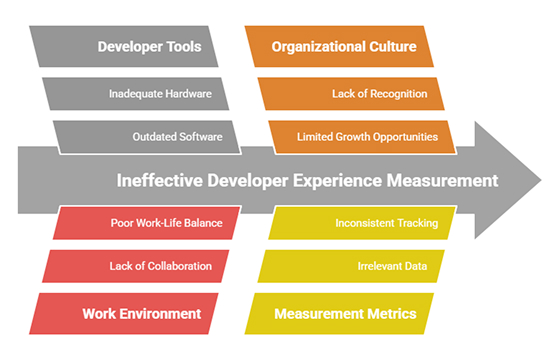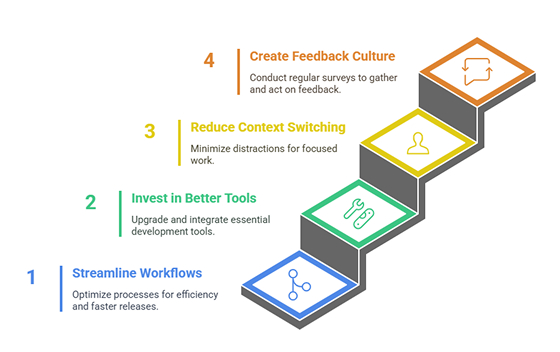In today’s fast-moving tech world, software engineers are at the core of innovation. A bad developer experience affects a company’s success.

That’s where the Developer Experience Index (DXI) comes in. It doesn’t focus on the lines of code written or the number of commits made. Rather, it’s a way to measure how smooth, effective, and enjoyable the software development process is. A strong DXI means developers are productive, engaged, and able to do their best work without unnecessary roadblocks.
But how do you measure something as nuanced as developer experience? By tracking the right data, organizations gain developer insights into what is working and what’s not.
What is the Developer Experience Index?
The Developer Experience Index is a framework designed to assess and improve the day-to-day work environment of software engineers. It goes beyond productivity numbers and considers factors like workflow efficiency, tooling, collaboration, and job satisfaction.
A great developer experience means:
- Fast feedback loops
- Clear documentation and onboarding
- Minimal interruptions or context switching
- Modern, well-integrated tools
- A culture that supports innovation and learning
When these factors are in place, developers work smarter, feel happier, and create better software. That’s why companies are now prioritizing DXI; it’s not just good for engineers, but for business success as well.
Why is it tricky to measure developer productivity?
Many organizations still rely on outdated ways of measuring developer productivity, such as:
- Lines of code written (more code doesn’t mean better software!)
- Number of commits or pull requests (this ignores problem-solving and design thinking)
- Hours worked (longer hours do not equal efficiency)
These metrics fail to capture the real story. A developer who refactors code to prevent future bugs might write less code but have more impact. Similarly, someone who mentors junior engineers might slow their own coding output but increase the team’s overall effectiveness.
Instead, DXI focuses on developer experience metrics that actually reflect productivity and well-being.
Key developer experience metrics
There are some key developer experience metrics to consider. These include:
- Lead Time for Changes: Time from code commit to production. Shorter lead times mean faster delivery and feedback
- Cycle Time: Time taken to complete a development task. Reduces bottlenecks in workflows
- Pull Request (PR) Size: Average number of lines changed per PR. Helps maintain manageable code reviews
- Mean Time to Recovery (MTTR): How quickly teams recover from failures. Faster recovery improves system reliability
- Onboarding Time: Time for new developers to become productive. Reduces friction in hiring and scaling
By tracking these, companies gain developer insights into where their teams struggle and how to improve efficiency.
How can you improve your DXI?
There are four steps that you can follow to significantly improve your DXI. These are:
1. Streamline Workflows
- Automate testing and deployments
- Ensure quick and constructive code reviews
- Use feature flags to release updates faster
2. Invest in Better Tools
- Provide fast, reliable CI/CD pipelines
- Standardize documentation and knowledge-sharing
- Ensure seamless integration between dev tools
To learn more, check out this guide on the 15 Best Developer Experience Tools.
3. Reduce Context Switching
- Limit unnecessary meetings
- Group similar tasks together
- Give developers dedicated time for uninterrupted coding
4. Create a Culture of Feedback
- Conduct regular DXI surveys
- Encourage open discussions on pain points
- Act on feedback to continuously improve processes

To learn more, check out this guide on the 10 top tips for improving developer productivity.
Common challenges in DXI implementation
Adopting DXI isn’t always smooth sailing. Here are a few hurdles companies face:
- Data overload: Too many metrics can lead to confusion. Focus on a few key indicators that truly impact developer experience.
- One-size-fits-all approach: What works for one team might not work for another. DXI should be tailored to specific workflows and company culture.
- Lack of buy-in from leadership: Some executives still believe in outdated productivity metrics. Educating leadership on the benefits of DXI is crucial.
- Short-term thinking: Improving developer experience is an ongoing process. Organizations need to commit to long-term changes, not just quick fixes.
Why does developer experience matter for business success?
Prioritizing DXI isn’t just about making developers happy; it has real business benefits:
- Faster time-to-market: Efficient workflows lead to quicker product releases.
- Higher retention rates: Developers who feel valued and supported are less likely to leave.
- Better code quality: Happier engineers write better, more maintainable code.
- More innovation: Less time spent fighting bad tooling means more time for creative problem-solving.
In short, a strong DXI leads to a more productive, engaged, and high-performing engineering team.
Concluding thoughts
DXI is a powerful tool for organizations that truly want to support their engineers. By focusing on meaningful metrics and measuring productivity in a thoughtful way, companies can gain valuable insights and create an environment where teams thrive.
Engineering isn’t just about writing code; it’s about solving problems, collaborating effectively, and continuously improving. By investing in DXI, businesses don’t just get better software; they get better teams, stronger culture, and long-term success.
